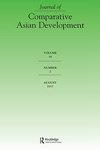Effectiveness of the Easing of Monetary Policy in the Japanese Economy, incorporating Energy Prices
Q3 Social Sciences
引用次数: 33
Abstract
Abstract Japan has reached the limits of conventional macroeconomic policies. In order to overcome deflation and achieve sustainable economic growth, the Bank of Japan (BOJ) recently set an inflation target of 2 per cent and implemented an aggressive monetary policy so this target could be achieved as soon as possible. Although prices started to rise after the BOJ implemented monetary easing, this may have been for other reasons, such as higher energy prices as a result of the depreciated Japanese yen. This paper shows that quantitative easing may not be able to stimulate the Japanese economy. Aggregate demand, which includes private investment, did not increase significantly in Japan with lower interest rates. Private investment displays this unconventional behaviour because of the uncertainty about the future and because Japan's population is ageing. The paper concludes that the remedy for Japan's economic policy is not to be found in its monetary policy.日本经济中货币政策宽松的有效性,包括能源价格
日本已经达到了常规宏观经济政策的极限。为了克服通货紧缩,实现可持续的经济增长,日本央行最近设定了2%的通胀目标,并实施了积极的货币政策,以便尽快实现这一目标。尽管价格在日本央行实施货币宽松政策后开始上涨,但这可能是由于其他原因,例如日元贬值导致的能源价格上涨。本文表明,量化宽松可能无法刺激日本经济。在利率较低的日本,包括私人投资在内的总需求并没有显著增长。私人投资之所以表现出这种非常规行为,是因为未来的不确定性和日本人口的老龄化。本文的结论是,日本经济政策的补救措施不能在其货币政策中找到。
本文章由计算机程序翻译,如有差异,请以英文原文为准。
求助全文
约1分钟内获得全文
求助全文
来源期刊

Journal of Comparative Asian Development
Social Sciences-Political Science and International Relations
CiteScore
1.30
自引率
0.00%
发文量
2
期刊介绍:
The Journal of Comparative Asian Development (JCAD) aims to offer the most up-to-date research, analyses, and findings on the many aspects of social, economic, and political development in contemporary Asia conducted by scholars and experts from Asia and around the world.
 求助内容:
求助内容: 应助结果提醒方式:
应助结果提醒方式:


